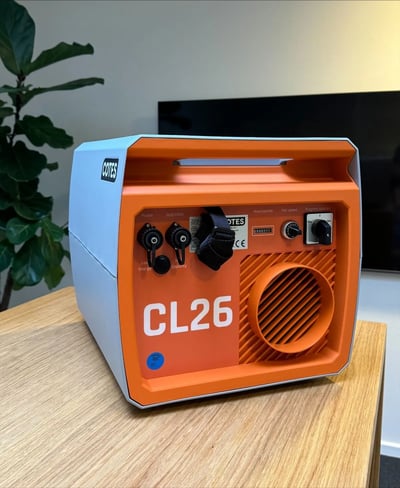Water damage restoration is critical in maintaining healthy, safe, and structurally sound environments. Prompt and efficient water removal and drying are essential to prevent microbial growth, material degradation, and increased restoration costs. Inspired by the ANSI/IICRC S500-2021 standard, this article outlines the importance of specifying desiccant dehumidification systems for effective water damage restoration.
Immediate Action for Safety and Efficacy:
The initial step in water damage restoration involves the removal of visible water using pumps, mops, and vacuum cleaners. Quick action is imperative to mitigate the risk of microbial contaminants, which can pose significant health risks, and to prevent swelling, cracking, and other forms of material degradation.
Specifying Dehumidification Capacity:
Desiccant dehumidification plays a pivotal role in the restoration process. The capacity needed can be specified as 0,7 to 1,1 L/h (20°C/60%RH) per 100m³ of room volume, adjusted according to the extent of water damage*. This ensures the restoration efforts are both efficient and effective. After surfaces are dry, dehumidification capacity can be reduced to 0,5 to 0,8 L/h per 100m³ of room volume.
Airflow Dynamics in Restoration:
Effective airflow dynamics are essential in the restoration process, particularly in the early drying stages. By maintaining an airflow velocity of at least 3 meters per second initially, the process not only enhances moisture evaporation from surfaces but also injects energy into materials. This energy transfer is crucial as it counteracts the cooling effect caused by evaporation, thereby minimising thermal tension within the materials that could lead to cracking.
As drying progresses and surfaces become less saturated, airflow velocity can be adjusted to 0,75 meters per second. Strategic placement of air movers in each room ensures uniform airflow, while dehumidifiers positioned thoughtfully can often maintain the reduced flow, further stabilising conditions to prevent material damage.
Temperature Considerations:
The effectiveness of desiccant dehumidifiers, like the Cotes CL26, is largely unaffected by temperature variations, maintaining consistent performance across conditions from below 0°C to above 35°C, meaning “one-unit fits all”.
Negative pressure:
Establishing a slight negative pressure within the environment is essential for containing and preventing the dissemination of mould and bacteria. This method is adeptly facilitated by our CL26 dehumidifier, which is designed to generate negative pressure in the room automatically.
Through this operation, the CL26 ensures that air flows inward rather than outward, effectively confining airborne contaminants within the area. This process helps maintain a healthier environment and significantly reduces the risk of contaminating adjacent spaces, making it an essential practice in mould and bacteria management during restoration efforts.
Quick and Easy Solution for getting rid of Reactivation Air:
A desiccant dehumidifier operates by dividing the incoming air into two distinct streams: a dry air stream used to dry out the water damage and a moist air stream, the latter also known as reactivation air.
The moist air would need to be expelled from the building. Cotes’ patent-pending window kit offers an easy way to install a desiccant dehumidifier in only 30 seconds.
Ergonomics and Safety:
Ergonomics is crucial in workplace safety, mainly during manual equipment handling, which is unavoidable in damage restoration. It aims to design tasks, workspaces, and devices to fit the user's physical capabilities, thereby reducing the risk of injury and enhancing productivity.
Recognising the importance of ergonomics, Cotes has developed the CL26 dehumidifier. Weighing just 10.8kg, it minimises the physical strain on users, ensuring a safer and more ergonomic handling experience.
Cotes recommends:
- For every 100m³ of a water-damaged area, use one Cotes CL26 dehumidifier.
- Add a flexible duct on the dry air outlet. Position the dehumidifier in a way that ensures the return airflow covers as many wet surfaces as possible.
- During the initial phase, adjust the hygrostat to 40%RH, set the dehumidifier to High-Capacity and constant flow modes, and supplement with external fans.
- Once surfaces are dry, switch the dehumidifier from High-Capacity to Low-Energy mode and either reduce the use of or completely remove external fans. Keep the hygrostat at 40%RH.
* Extent of water damage is here given by a class 2 (low number) and class 3 (high number):
Class 2 Water Damage is characterised by a significant amount of water absorption and evaporation load. It involves water intrusion where wet porous materials (like carpet, gypsum board, fibre-fill insulation, concrete masonry unit, and textiles) represent approximately 5% to 40% of the space's combined floor, wall, and ceiling surface area. The materials described as low evaporation materials or assemblies have absorbed minimal moisture.
Class 3 Water Damage is marked by the greatest amount of water absorption and evaporation load. This type of damage occurs when water intrusion affects more than 40% of the space's combined floor, wall, and ceiling surface area, involving wet porous materials similar to those in Class 2. Like Class 2, the materials considered low evaporation materials or assemblies have also absorbed minimal moisture.

